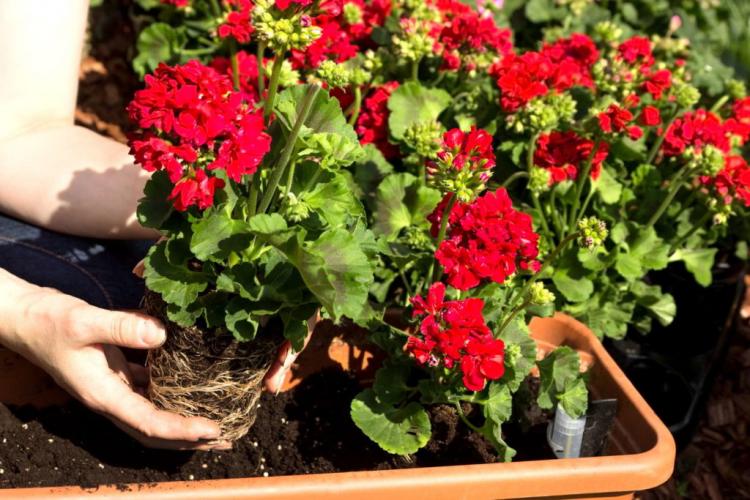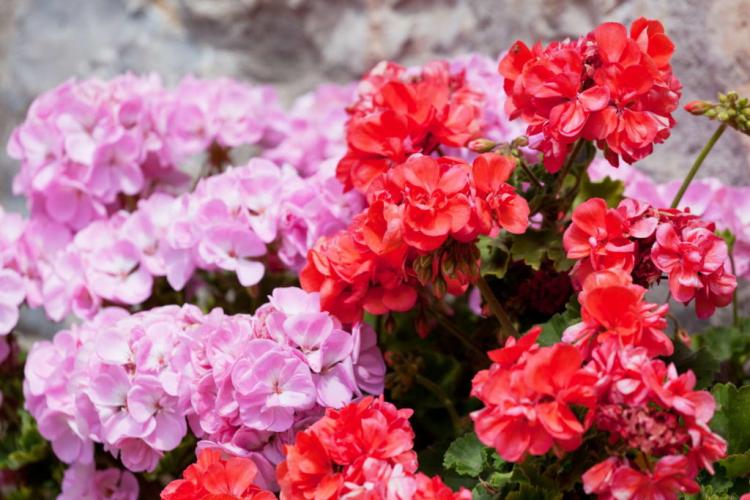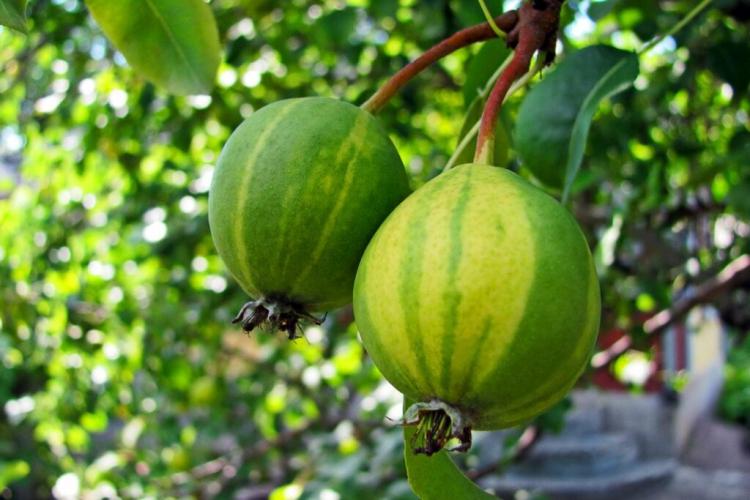Fertilize Geraniums: For The Perfect Flowering
Geraniums need to be properly fertilized so that their flowers can shine. We have compiled all the important facts about fertilization for you.

The flowers of the geranium make it a real heavy eater who is happy about regular fertilization [Photo: Anna Minsk / Shutterstock.com]
Pelargoniums ( Pelargonium ), also popularly known as geraniums, with their abundant flowering in summer, are welcome residents of balconies and gardens. The leafy South Africans are not only beautiful to look at, but also quite undemanding when it comes to their care needs. However, there is one thing they need in large quantities: nutrients. However, especially with pot cultures, the plants have only a few options to meet their nutrient requirements with resources from the soil. That is why there should not be a lack of appropriate, regular fertilization. Otherwise your geraniums lack the basis for the formation of their filigree flower coat. With the right fertilization, on the other hand, the plants show their lush flowers not only in maximum number, but also particularly long and intensely colored.
Geraniums are among the strong eaters – no wonder, because the delicate plants only sprout properly in spring and form shoots, which they decorate with countless colorful flowers. This vigor consumes heaps of nutrients. Accordingly, you should also attach great importance to fertilizing your colorful exotic species. So that your geraniums literally drown in colorful flowers, we clarify the most important questions about fertilizing geraniums: What is the best way to fertilize geraniums? How often are geraniums fertilized and when?
When to fertilize geraniums
Table of Contents
Geraniums are fertilized immediately when planting or when repotting with a slow release fertilizer such as ripe compost in combination with horn shavings or horn meal. Alternatively, you can also put your plants in geranium soil. This contains a starter fertilizer that is perfectly adapted to the needs of these floral wonders.

You can fertilize the geraniums for the first time when you are planting or repotting [Photo: Tibanna79 / Shutterstock.com]
The first maintenance fertilization is then due three to four weeks after the plant fertilization. Because of their high nutritional requirements, geraniums should be fertilized every one to two weeks with liquid fertilizer in the irrigation water. Even when using a slow release fertilizer that you give in spring around February / March, you should top up your fertilizer from time to time. Because the fertilizers release their nutrients over the entire growth phase, but this does not happen evenly. This can lead to nutrient shortages, especially in summer during the flowering phase. Organic fertilizers are particularly suitable here. Due to the complex form in which the nutrients are present, these have a natural long-term effect and do not have to be chemically treated like mineral fertilizers in order to make them available. From September to October you can then reduce the fertilizer intake. There is then no longer any fertilization in the winter quarters. The plants are dormant at this time and accordingly have hardly any need for nutrients.
Which geranium fertilizer to use?
When fertilizing geraniums, it is very easy and safe to use a special fertilizer for precisely this type of plant. This offers a high concentration of nutrients and a particularly large amount of iron for the hungry plants. But a fertilizer for flowering or balcony plants is also sufficient and is usually even a little cheaper and more universal. Most of the time, geraniums are not the only flower carriers on the balcony at home. You should make sure that the potassium content is greater than the nitrogen content. Otherwise, your geraniums invest their energy mainly in the formation of shoots and leaves, but not in the flowers. In addition, a little phosphate – and the basic needs of your geraniums are covered. Our Plantura organic flower fertilizer is ideal for supplying your geraniums and other flowering plants. It offers extra potassium and phosphate for a long, lush flowering and intensive flower colors. Most of the production uses organic ingredients of perfect organic quality. As a result, the nutrients are released into the soil over a long period of time, because they first have to be converted by soil organisms. So you are doing them another favor and ensuring a healthy soil life. And this in turn improves the soil quality and supports your plants in two ways.

Our Plantura organic flower fertilizer offers the geranium extra potassium and phosphate for lush and long flowering
The supply of other minerals and trace elements is also important. These are usually present in sufficient quantities in the soil, but pot cultures only have a limited storage volume and are therefore quickly depleted. Deficiency symptoms can occur so quickly, especially with iron and magnesium. However, iron deficiency is more often caused by incorrect soil pH than an actual deficiency. Make sure that the pH value in the soil of geraniums is between 5.5 and 6.0. Here the iron is available in sufficiently large quantities in a form that can be taken up by plants. If the value increases too much, fertilizing with coffee grounds or Epsom salt will help. The administration of Epsom salt not only lowers the soil pH value, but also provides the plants with sufficient magnesium. This is used to build up chlorophyll, the green leaf pigment. The addition of magnesium not only ensures that the leaves are lush, the plants are also less susceptible to diseases and pests.
Fertilize geraniums properly: Instructions for ideal application
Correct fertilization, however, does not only include choosing a suitable fertilizer. You should also choose the dosage, application and the intervals between fertilizations professionally. Depending on the selected fertilizer – organic or mineral – there are some differences in handling to consider.
You Might Also Like Plants That Don’t Like Mushroom Compost
Organically fertilize geraniums
Organic fertilization means doing something for the environment, because natural fertilizers such as compost or manure, but also organic fertilizers from specialist retailers are produced in a resource-saving and sustainable manner. Compared to the mineral variant, they provide your geraniums with the necessary nutrients much more gently but just as efficiently, because the ingredients are only gradually released in the soil through a conversion process. This reduces the risk of over-fertilization, which in the worst case can lead to the death of the plant. This makes organic fertilizers much easier to use. Nevertheless, even here you can’t just spread a couple of hands in the bed with good luck. To ensure that the fertilization is successful, we have put together below instructions for handling our Plantura organic flower fertilizer, which comes from almost exclusively organic sources.
- Before planting, work 100 – 150 g / m² (well-filled 0.2 liter jar) of our Plantura organic flower fertilizer into the upper soil layer
- Pour the soil and freshly planted geranium well so that the granules can dissolve well
- With maintenance fertilization in spring, you should fertilize another 80 – 120 g / m² (0.2 liter jar) per plant
Be careful not to wet the leaves and flowers when watering after fertilizing. The moisture provides an ideal soil for a fungal attack. In the case of poor soils, it is advisable to improve them with rock flour. This is rich in minerals and trace elements. In this way, your geraniums are primarily supplied with the iron and magnesium that are important for them. Make sure, however, that rock flour raises the soil pH. Therefore, you should dose rather low.

Organic fertilizers provide your geraniums with nutrients more gently than mineral fertilizers, but are just as efficient [Photo: Shchipkova Elena / Shutterstock.com]
Fertilize geraniums with minerals
Geraniums need a consistently high supply of nutrients. Mineral fertilizers can therefore be exactly the right thing for your geraniums in terms of their active principle. These fertilizers are highly concentrated and usually immediately available to the plant. However, you should bear in mind that the nutrients are not only quickly available to the plant due to their water solubility, but also quickly pass into the groundwater. With this and the complex manufacturing process, they pollute the environment much more than the use of organic fertilizers. However, if you do want to use a mineral product, you should never ignore the manufacturer’s instructions regarding the dosage, even for plants with cravings such as geraniums. Otherwise, chemical burns in the fine root area will quickly occur and your geraniums will suffer. When using blue grain, you should dissolve a tablespoon of the granules in 10 liters of water. You can then use this solution for watering once a week.
You can find more information on caring for geraniums in our special article.





